Paddlefish
Paddlefish have existed since the Cretaceous Period
Advertisement
Paddlefish Scientific Classification
Read our Complete Guide to Classification of Animals.
Paddlefish Conservation Status
Paddlefish Facts
- Prey
- Zooplankton
- Fun Fact
- Paddlefish have existed since the Cretaceous Period
- Biggest Threat
- Humans
- Most Distinctive Feature
- Long, paddlelike snout
- Other Name(s)
- Mississippi paddlefish, spoonbill
- Gestation Period
- 7 days
View all of the Paddlefish images!
The paddlefish, also known as the American paddlefish, Mississippi paddlefish, and spoonbill fish, is a freshwater fish that is primarily found in the open waters of the Mississippi River basin.
With the Chinese paddlefish, it was one of just two extant species of paddlefish in the world. In 2020, however, the Chinese paddlefish was declared extinct, leaving the American paddlefish as the only remaining species in the world.
Paddlefish can sometimes be called spoonbill fish, spoonbill cat, or shovelnose cat because some of these types of fish have been mistaken for the paddlefish as a member of the catfish family. It is also one of the four cartilaginous fish that are native to Texas.
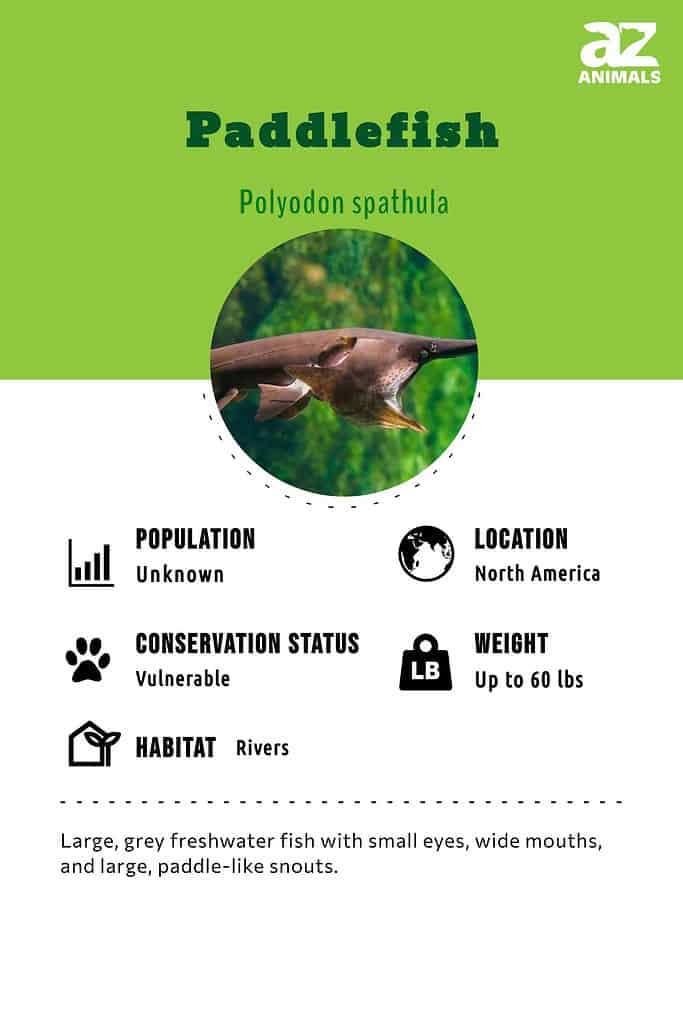
5 Incredible Paddlefish (Spoonbill Fish) Facts!
- Filter-Feeders: Despite their large size, these fish are filter-feeders, subsisting almost entirely off of zooplankton that it consumes by opening their large mouth wide and filtering food from water through their gill rakes.
- Caviar: Paddlefish roe can be processed into caviar that is similar in color, texture, size, and taste to caviar produced from sturgeon roe from the Caspian Sea; this caused overfishing of the species until restrictions were enacted.
- One Remaining Species: Sadly, the Chinese paddlefish – nicknamed “the panda of the Yangtze” – was declared extinct in 2020; the last confirmed sighting of the species happened in 2003.
- Electroreception: Paddlefish use electroreceptors on their rostrums – their pointed, paddlelike snouts – to detect prey, and they rely on this method much more than on eyesight.
- Primitive Fish: Because they have undergone few changes since the early Cretaceous period, roughly 120 to 125 million years ago, paddlefish are considered to be primitive fish.
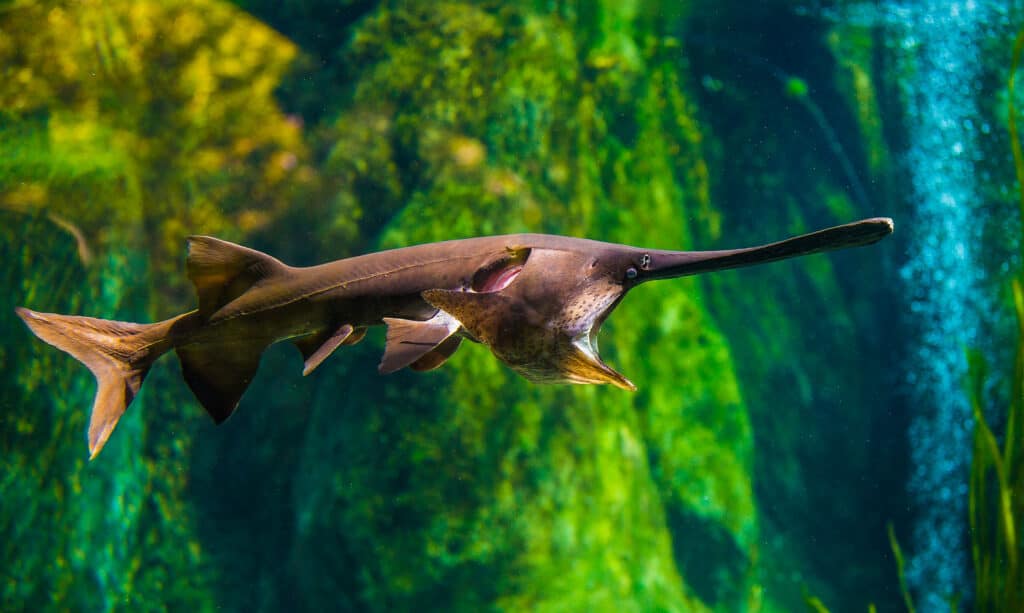
Paddlefish belong to the same order as sturgeons and produce edible roe.
©Saran Jantraurai/Shutterstock.com
Classification and Scientific Name
These fish belong to the order Acipenseriformes, which includes sturgeons, and to the family Polyodontidae. The American paddlefish, the only extant species of paddlefish (spoonbill fish), belongs to the genus Polyodon, and its scientific name is Polyodon spathula. The Chinese paddlefish, which was declared extinct around 2005, belonged to the genus Psephurus; its scientific name was Psephurus gladius.
All told, six species of paddlefish are known to have existed. Four of them are only known from the fossil record; three of those species were native to North America, and one was native to China. The Chinese paddlefish recently went extinct, rendering the American paddlefish the only extant species.
In terms of etymology, the term Polyodon comes from the Greek and means “many toothed.” The term spathula is derived from the word spatula and describes the shape of the creature’s paddlelike rostrum.
Species
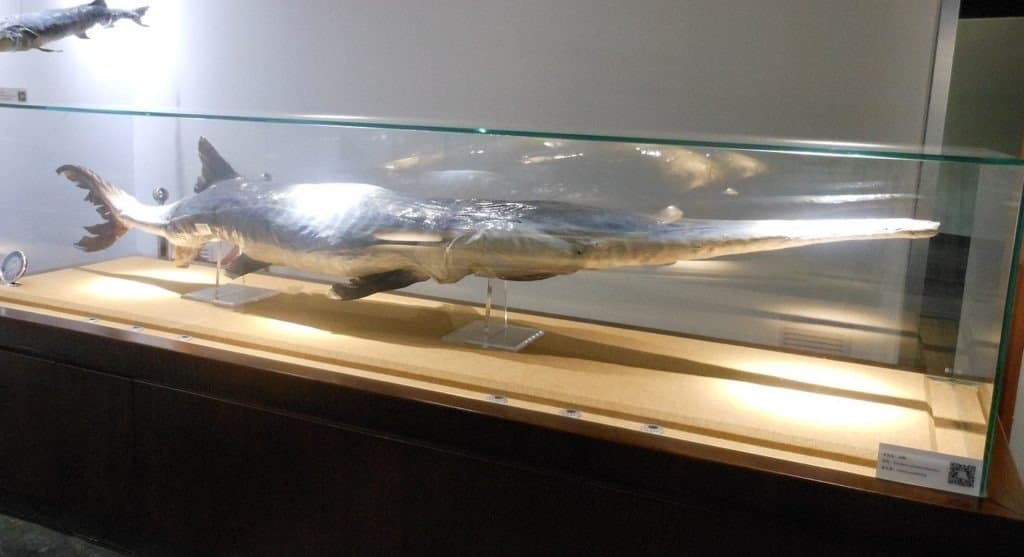
Chinese paddlefish are now extinct – leaving only the American paddlefish.
©Alneth / CC BY-SA 4.0 – License
The only extant species is the American paddlefish, P. spathula. More information about this species is found in the following sections.
Until recently, one other species of paddlefish remained in the world – the Chinese paddlefish, P. gladius. Endemic to the Yangtze River basin, the Chinese paddlefish – also known as the Chinese swordfish and the elephant fish – was larger than the American species.
On average, it was around 10 feet in length. The species could attain a size of up to 23 feet long and up to 1,000 pounds, making it one of the largest freshwater species of fish in the world. The largest specimen ever caught measured a record 9.8 feet in length and weighed 661.4 pounds.
The Chinese paddlefish (spoonbill fish) also differed significantly from its American counterpart in that it was a highly predatory piscivore, meaning that it subsisted almost entirely on fish. The American species, in contrast, is a filter-feeder that subsists almost exclusively off of zooplankton.
Evolution
The earliest vertebrates are believed to be the ancestors of the hagfish with their fossils dating from around 550 million years ago. Paddlefish are considered to be primitive fish because Acipenseriformes are amongst the earliest diverging lineages of ray-finned fish. These fish diverged from all other living groups over 300 million years ago and haven’t changed much since the early Cretaceous period, roughly 120 to 125 million years ago. Paddlefish exist in the fossil record almost exclusively in what is now China and North America.
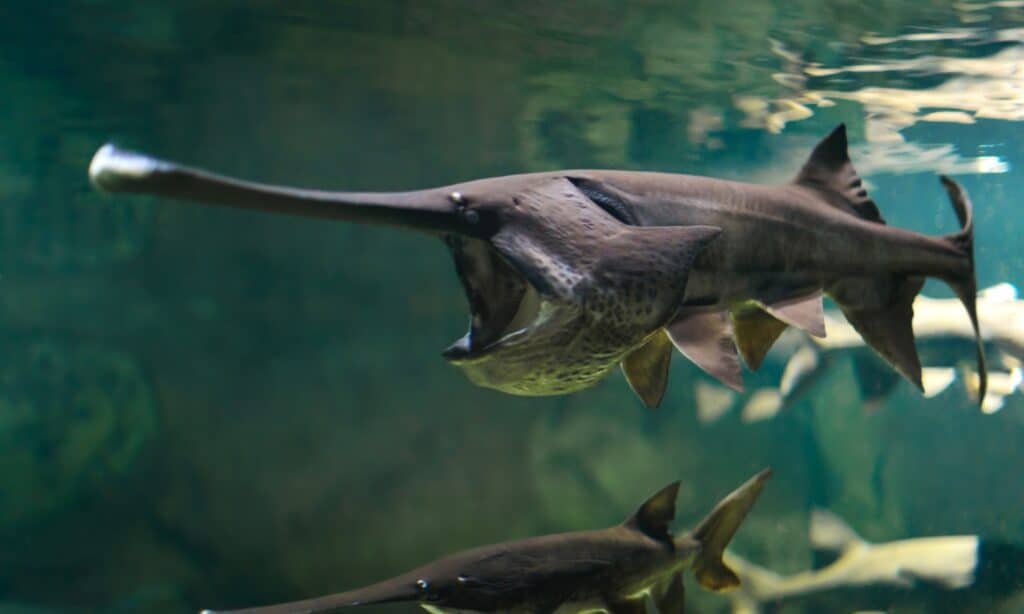
The paddlefish has small, poorly developed eyes, a wide mouth, and a long, paddle-like snout.
©iStock.com/NataliaBelay
Paddlefish Appearance
A relative of the sturgeon, the American paddlefish – henceforth called simply the paddlefish – is an archaic freshwater fish with a cartilaginous skeleton. Its smooth skin is typically gray or green in color, and the fish reaches an average size of roughly 5 feet long and around 60 pounds.
However, some paddlefish can grow as large as an average of 7.2 feet long and up to 200 pounds.
The largest paddlefish on record, caught in Iowa in 1916, measured 7.1 feet in length, had a girth of 45.5 inches and weighed more than 198 pounds.
These primitive fish have small, poorly developed eyes, wide mouths, and large, paddle-like snouts. Technically known as a rostrum, the snout is actually an extension of the cranium. Its ampulla, or hair cells, contain electroreceptors that can detect electrical fields signaling the presence of prey – typically zooplankton.
In fact, these receptors are sensitive enough to detect the individual movements of a zooplankton’s appendages, allowing them to forage for prey more effectively. They also have sensory pores on the surface of roughly half of their bodies that also help make up for their poor eyesight.
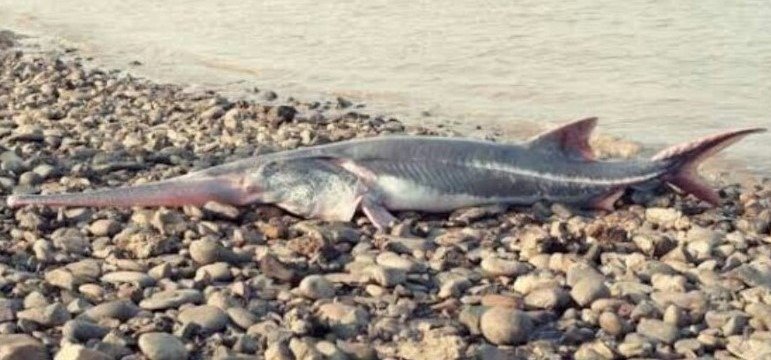
The Chinese paddlefish went extinct after it was overfished and a dam development disrupted migration patterns.
©จุฑาปกรณ์ ประกอบมี / CC BY-SA 4.0 – License
Distribution, Population, and Habitat
As noted previously, the Chinese paddlefish was declared extinct in 2020. It was classified as Critically Endangered by the IUCN in 1996; the last confirmed sighting was in 2003, and it is believed to have disappeared between 2005 and 2010. Overfishing in the 1970s depleted its populations, with more than 25 tons being harvested per year. The development of the Gezhouba Dam in 1981 split their populations in half, disrupting migration patterns and interrupting upstream breeding.
The American paddlefish is hardly in the clear. The species has been classified as Vulnerable by the IUCN since 2004; its populations have declined for various reasons, and the species has been extirpated from previous habitats in New York, Maryland, Pennsylvania, Lake Huron, and Ontario, Canada.
International trade of these fish has been restricted since 1992. Poaching of the species escalated during the 1980s when a trade embargo on Iran restricted imports of beluga caviar from the Caspian Sea. Demand for alternatives – namely caviar from the roe of paddlefish and sturgeon – skyrocketed, putting populations at risk. The species is also endangered from the infestation of zebra mussels, an invasive species, in the Mississippi River. Like paddlefish, zebra mussels are filter-feeders. They rapidly depleted available levels of zooplankton, causing declines in paddlefish populations. Today, various protections are in place at the state and federal levels, and the species is also protected under the CITES act.
Today, the American paddlefish’s range is mostly found in the Mississippi River basin across 22 U.S. States. They are found from New York to Montana and south to the Gulf of Mexico. Their habitats mostly consist of medium to large rivers, backwater lakes, and bayous.
Predators and Prey
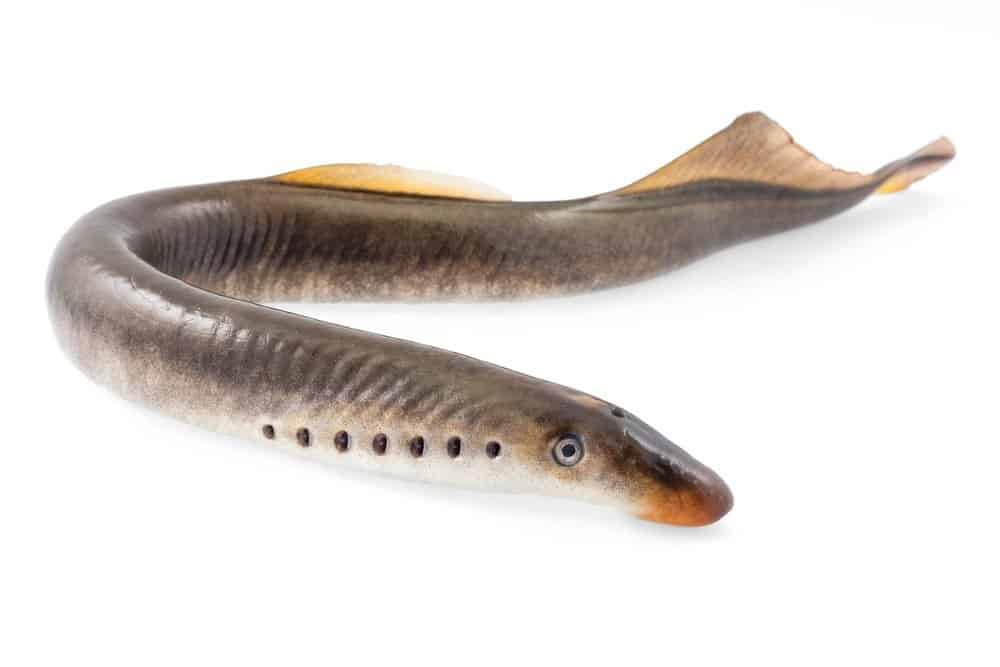
River lamprey is a parasite that attaches to paddlefish with multiple lampreys able to kill the fish.
©Andrei Nekrassov/Shutterstock.com
What eats Paddlefish?
Thanks to their size, these fish face few predators in the wild. However, they are parasitized by lampreys. A single lamprey typically only wounds the fish. Sometimes, however, multiple lampreys attach to a paddlefish at once, typically killing it.
What do Paddlefish eat?
These fish primarily prey on zooplankton, consuming them through filter-feeding. However, they are also known to occasionally consume small insects and their larvae and small fish.
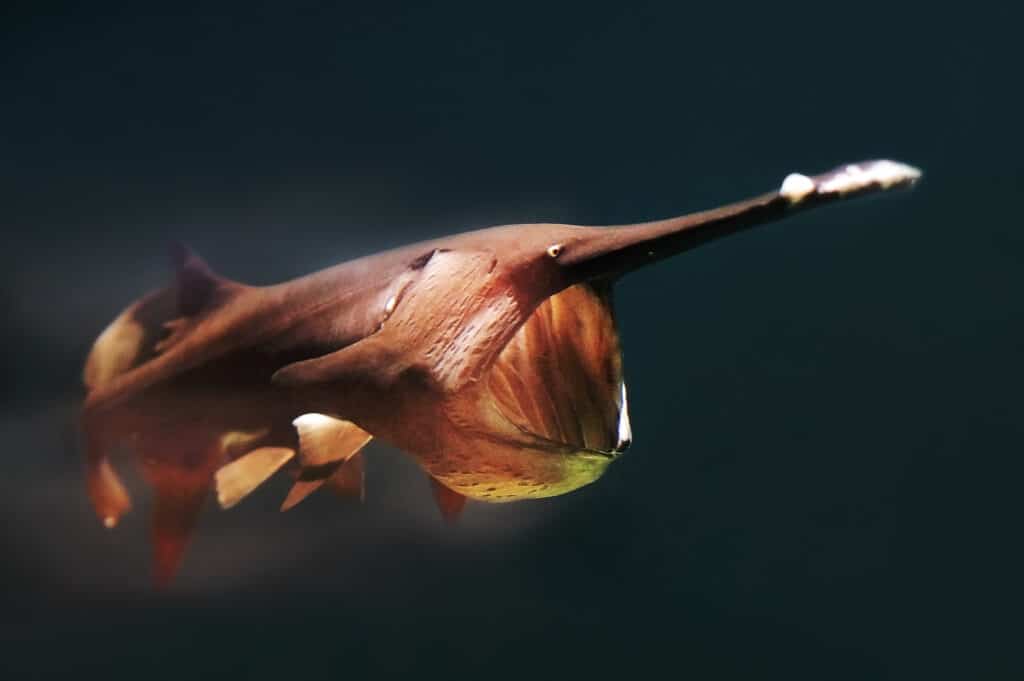
Paddlefish use their large gills and mouths to capture zooplankton.
©Marina Veder/Shutterstock.com
Reproduction and Lifespan
The American paddlefish is a long-lived fish with an average lifespan of around 30 years. They don’t reach sexual maturity until later in life. Females reach sexual maturity between the ages of 7 and 10 on average; some don’t until as late as 16 to 18 years of age. Males typically reach sexual maturity around the age of 7, but some don’t until as late as 9 to 10 years of age.
These fish spawns during the late spring. The conditions have to be exactly right; if things like temperature, water flow, and gravel substrate availability aren’t optimal, they may not spawn at all. Females are believed to spawn every second or third year while males spawn every year or every other year.
These fish migrate upstream to spawn. Their precise migration range is unclear, but they have been known to travel more than 2,000 miles in a river system. As broadcast spawners, or mass spawners, females release their eggs onto bare gravel and rocks; at the same time, males release their sperm. Fertilization happens externally, and the adhesive eggs become attached to rocky substrates. The average incubation time is around seven days. Young is then swept downstream to develop in deep freshwater ponds.
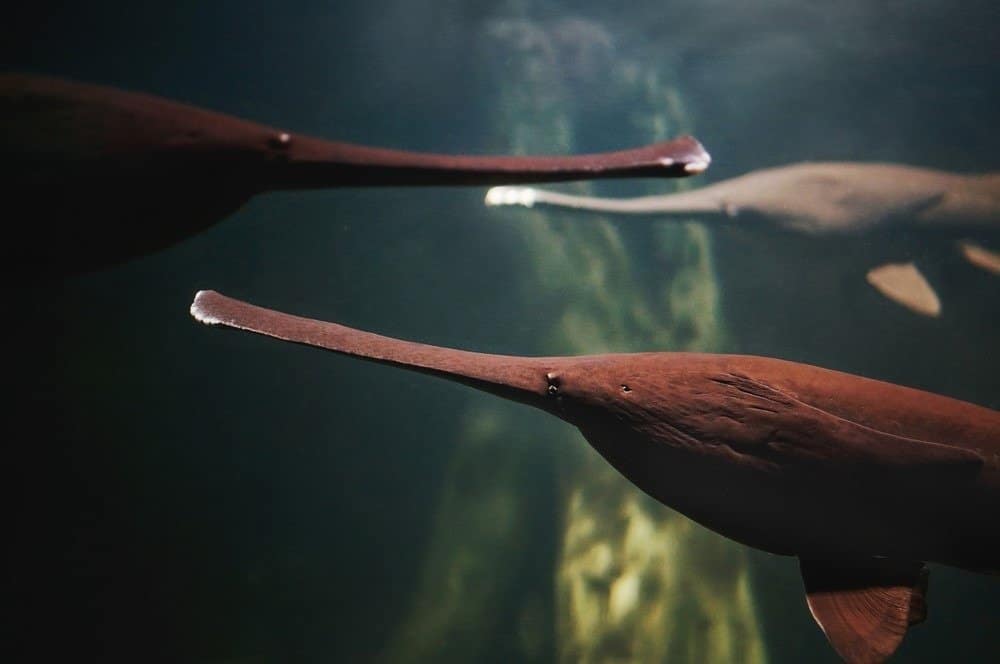
Paddlefish roe is often processed into caviar and its flesh is likened to catfish and swordfish.
©Marina Veder/Shutterstock.com
Fishing and Cooking
As noted previously, paddlefish roe is often processed into caviar. As for its flesh, the texture is likened to that of catfish and the taste to that of swordfish. However, due to restrictions on the harvesting of these fish, they are not popularly consumed. As filter-feeders, they don’t take bait or lures – snagging is the only technique that works when fishing for this species. Still, paddlefish are popular game fish, and fishing of the species is permitted in the following states: Arkansas, Illinois, Indiana, Iowa, Kansas, Mississippi, Missouri, Montana, Nebraska, North Dakota, Oklahoma, South Dakota, and Tennessee.
View all 192 animals that start with PPaddlefish FAQs (Frequently Asked Questions)
What is a paddlefish?
A paddlefish is a primitive freshwater fish that is endemic to the Mississippi River basin.
What do paddlefish eat?
The American paddlefish is a filter-feeder and subsists almost entirely off of zooplankton. However, it occasionally eats small insects, insect larvae and small fish.
Can you eat paddlefish?
Humans sometimes consume paddlefish; their taste is likened to that of swordfish. However, restrictions on this vulnerable species make it fairly unpopular for cooking.
Is it legal to catch paddlefish?
Fishing of paddlefish is permitted in 13 states. In most cases, however, only catch-and-release fishing is allowed.
How many paddlefish are left in the world?
Population estimates for paddlefish are not available. However, the only extant species, the American paddlefish, is listed as Vulnerable by the IUCN.
What Kingdom do Paddlefish belong to?
Paddlefish belong to the Kingdom Animalia.
What phylum do Paddlefish belong to?
Paddlefish belong to the phylum Chordata.
What class do Paddlefish belong to?
Paddlefish belong to the class Actinopterygii.
What family do Paddlefish belong to?
Paddlefish belong to the family Polyodontidae.
How do Paddlefish have babies?
Paddlefish lay eggs.
What are the differences between paddlefish and sturgeon?
The key differences between paddlefish and sturgeon are their appearance, diet, and lifespan. The tops of sturgeons and paddlefishes are dark, but the pigmentation fades into much lighter ventral colors, and many have white bellies.
Thank you for reading! Have some feedback for us? Contact the AZ Animals editorial team.
Sources
- Fishbase, Available here: https://www.fishbase.se/summary/4513
- Smithsonian Magazine, Available here: https://www.smithsonianmag.com/smart-news/chinese-paddlefish-which-lived-200-million-years-now-extinct-180973938/
- Britannica, Available here: https://www.britannica.com/animal/paddlefish

















